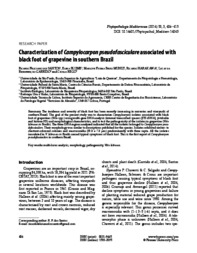Characterization of Campylocarpon pseudofasciculare associated with black foot of grapevine in southern Brazil.
Characterization of Campylocarpon pseudofasciculare associated with black foot of grapevine in southern Brazil.
Author(s): SANTOS, R. F. dos; BLUME, E.; MUNIZ, M. F. B.; HARAKAWA, R.; GARRIDO, L. da R.; REGO, C.
Summary: The incidence and severity of black foot has been recently increasing in nurseries and vineyards of southern Brazil. The goal of the present study was to characterize Campylocarpon isolates associated with black foot of grapevines (Vitis spp.) using multi-gene DNA analysis (internal transcribed spacers [ITS rDNA], (beta)-tubulin and histone H3) and morphological characteristics, and to test the pathogenicity of the isolates in grapevine (Vitis labrusca cv. Bordô). The three DNA regions analyzed indicated that all the isolates belonged to Campylocarpon pseudofasciculare. Their morphology was similar to descriptions published for the species. Isolates exhibited umber- to chestnut-coloured colonies and macroconidia (38.0 × 7.0 (micro)m) predominantly with three septa. All the isolates inoculated in V. labrusca cv. Bordô caused typical symptoms of black foot. This is the first report of Campylocarpon pseudofasciculare in southern Brazil.
Publication year: 2014
Types of publication: Journal article
Unit: Embrapa Grape & Wine
Keywords: Doença de planta, Doença fúngica, Genética, Grapes, Morfologia, Uva, Videira, Viticultura, Viticulture, Vitis labrusca
Observation
Some of Embrapa's publications are published as ePub files. To read them, use or download one of the following free software options to your computer or mobile device. Android: Google Play Books; IOS: iBooks; Windows and Linux: Calibre.
Access other publications
Access the Agricultural Research Database (BDPA) to consult Embrapa's full library collection and records.
Visit Embrapa Bookstore to purchase books and other publications sold by Embrapa.

